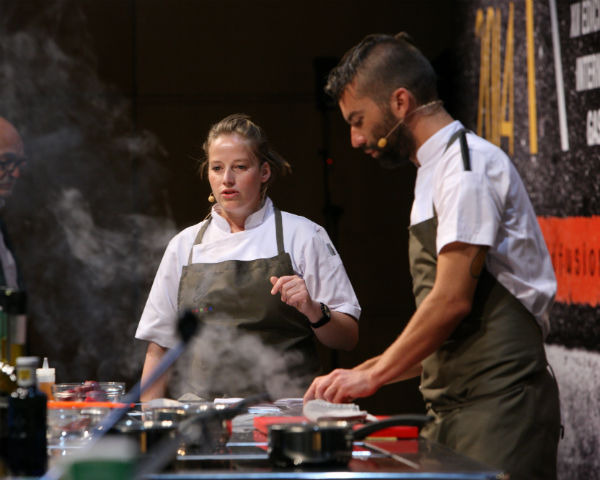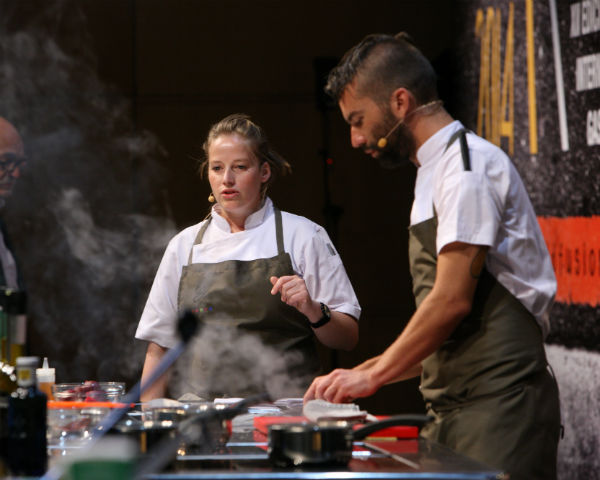Madrid Fusión Day 3: Ferran Adrià Reveals A New Plan
Ferran Adrià used the forum of Madrid Fusión in 2010 to announce the impending closing of elBulli as a restaurant, and returned in 2011 to showcase architectural renderings of the elBulli Foundation that will eventually take its place. He hasn't been to the conference since, and isn't here now, but two of his top "creative team," chefs Oriol Castro and Eduard Xatruch, took the stage in the auditorium at Madrid's Palacio Municipal de Congresos today, on the third and final day of Madrid Fusión, to talk about the massive BulliPedia project that Adrià and his colleagues have been working on for the past few years.
See Madrid Fusión Day 1, Madrid Fusión Day 2
Their presentation was preceded by a video welcome from Adrià, in which he announced that he will consolidate his Barcelona workshop and research operations into a huge new space in the city — a brief video look at it suggests that it's the size of an airplane hangar — which will house 70 or 80 people at a time, all working on BulliPedia. The results of their labors will be shared in real time daily with "all the chefs in the world," with the help of one of Adrià's sponsors, the Spanish telecommunications giant Telefónica. Meanwhile, the long-delayed groundbreaking for the elBulliFoundation on the site of the former restaurant in Cala Montjoi is now scheduled for May, with completion of construction expected by the end of 2015.
After the video, Castro and Xatruch began a presentation that was tantalizingly billed as "50 Questions That Will Change the Way We Understand Cuisine: Decoding the Culinary Genome." In fact, said Xatruch, "We have not 50 questions but 50,000, and the more we ask ourselves the more we think of. Fortunately, now we have the luxury of time to think." The two didn't offer 50 sample questions, but they did present a few: "When does cuisine begin? If I take a banana and peel it and give it to someone, is that cuisine? What if I take some strawberries and put them on a bed of ice and then arrange a few nice ones on top. Is that cuisine? But speaking of strawberries, what is fruit? I have an avocado here, and to the Spanish it is a vegetable; in South America, it's eaten like a fruit." Demonstrating the common Spanish technique of drizzling bread with olive oil and covering it with puréed tomato and a slice of jamón, he said "When you start to think in this way, you realize that this very simple dish is actually more complex than anything we made at elBulli. Someone had to grow the wheat and bake the bread. Someone made the oil and the ham and grew the tomatoes. So many steps went into it so that it could be simple. This is the kind of thing we're thinking about."[pullquote:left]
The morning had gotten off to an Andean start, with chefs representing Peru, Chile, and Bolivia demonstrating not just their cooking techniques but their persistence in discovering and figuring out how to use "new" ingredients formerly known only by indigenous peoples (who of course don't cook them sous-vide or arrange them on their plates with tweezers or squeeze bottles).
Gastón Acurio, the Peruvian chef–restaurateur, is the star of contemporary Latin American cuisine (at least if we exclude Brazil from the definition for the moment), but almost as well-known and respected, at least in Peru itself, is Virgilio Mártinez, who runs Central Restaurante in Lima, as well as the Michelin one-star Lima London, in the English capital. He arrived in Madrid with some chuño, the naturally freeze-dried Andean potatoes, and some dried alpaca heart. He had grated the chuño and made it into a paste with chia seeds, then dehydrated it into thin wafers. The alpaca heart, marinated in chiles and herbs, was grated over the wafer and garnished with a kind of aromatic wild Andean mint. Martínez also works with such products as a kind of medicinal clay from Lake Titicaca, white cacao pulp, mullaca (or wild tomato), and even coca leaves and husks.
Rodolfo Guzmán of Boragó in Santiago, Chile, talked of how some indigenous Chileans cooked not on fire but on embers placed on sand. He reproduced this method onstage, with fragrant smoldering tepu wood, over which he draped damp marine chard to cook. This he combined with a variety of large sea snail, purslane, a type of keffir popular in Chile, and a kind of fleshy, intensely flavored berry. He also made a dessert with thorntree berries blended with chocolate and also made into a crumble.
Kamilla Seidler and Michelangelo Cestari of Gustu in La Paz, Bolivia
Danish-born Kamilla Seidler and Venezuelan-born Michelangelo Cestari are the chefs at Gustu, opened last year in La Paz, Bolivia, by Claus Meyer, one of the founders of Noma in Copenhagen. They spoke of the challenges of cooking at 14,000 feet above sea level, and their determination to use all local products (including mountain trout and, yes, Bolivian wines). Then there was getting to understand the llama. "We didn't know what to do with the meat," said Cestari. "The myth was that it was tough and flavorless, but we found that it was very east meat to cook. It's very lean, very high in protein, and it grills very nicely. Now we're starting to work with llama milk. The indigenous people don't have the proteins they need to digest dairy products, so have never paid much attention to the milk, but in trying to create a Bolivian gastronomy, we are using it to make yogurt." They are also beginning to work with high-altitude cactus fruit, honey made from Amazonian bees the size of tiny flies, and a potato-like tuber called papalisa or ulluco.
Gastón Acurio himself, widely credited with having inspired the contemporary culinary scene in Latin America through his Astrid & Gastón in Lima and now many other restaurants around the world, spoke poetically of 7000 years of Peruvian cuisine and of how his generation was brought up in the dark, ignorant of its heritage, looking to France for culinary inspiration. This began to change about 20 years ago, he continued, and now chefs all over the region are redefining the relationship of cooks to other people, and discovering the traditions and ingredients that surround them. "We used to hide in our kitchens, trying to survive. One day we came out and discovered that Peru was a diverse country, and that we had 2000 kinds of potato, 200 chiles, 400 varieties of corn." His chef de cuisine, Diego Muñoz, demonstrated a dish of chile-marinated horse mackerel with its own toasted bones, crystallized sea lettuce, and wild tomatoes, and one based on "ham" made from lobster tail. Acurio is closing his original restaurant in a few days, he said, and in mid-February will reopen on a much larger scale in a 300-year-old palace, complete with cooking school, laboratory, and kids-only botanical garden.
Two highlights of the afternoon session were a couple of imports: Pino Cuttaia from La Madia in the Sicilian town of Licata, and Bertrand Grébaut from the celebrated Parisian restaurant Septime. Cuttaia ran changes on Sicilian tradition by making pasta alla Norma with the eggplant on the inside (a tube of thin eggplant filled with eggplant mousse and wrapped in a long baby eggplant, wrapped up in curls of angel hair pasta cooked in saffron water) and presenting boiled small octopus atop a false rock made from solidified octopus cooking water; parsley mayonnaise, chickpea cream, mussel and caper water, and lentils dehydrated and then ground to resemble sand were also involved. Grébaut's contributions were simple but delicious looking, including raw scallops "cooked" in acidulated milk with feta and hazelnut oil, and squid in red wine sauce with onions roasted in their own juices and a few pieces of sausage from the Jura.
Pino Cuttaia of La Madia in Licata, Sicily
Walking around the exhibition floor between sessions, I ran into — among others — writer/photographer and wine importer Gerry Dawes (whose knowledge of all things Spanish is encyclopedic), Jeffrey Weiss (proprietor of Jeninni in Pacific Grove, Calif., and author of the forthcoming book Charcuteria: The Soul of Spain), and Maria José San Roman (grinning broadly because her Taberna del Gourmet in Alicante had just been named Spain's best tapas bar in the new Solan de Cabras guide to the country's 100+1 best restaurants, and because business had been booming at her Monastrell since Michelin gave it a star last year).
Jorge Mas of Mas Gourmets, the Barcelona-based charcutier, gave me samples of his latest flavors of mini-fuets (small Catalan sausages), one flavored with black truffles, one with smoked mozzarella, and one, extraordinary, made with jamón ibérico. I also sample a line of new packages he is selling at his stores, a pulltop can filled with cheese mousse, crumbled pork cracklings, and mild white sausage, and a box with slices of full-size fuet made according to his grandfather's recipe from 1945 along with slices of regular longaniza and longaniza rimmed in black pepper. Mas told me there are still difficulties to surmount, but he hopes to be able to open his first U.S. store in September in Miami.
Of the many other things I tasted over the past three days, three cheeses stand out: These were at the Poncelet stand, Poncelet being a Madrid cheese shop and cheese restaurant, and included an aromatic soft white goat cheese from Fresnedillas de la Oliva, near Madrid; a wonderful sweet and fruity goat and sheep cheese from the Canary Islands called Bodega; and a pimentón-flavored cow's milk cheese from Asturias, Afuega'l Pitu.
And among the many wines I sampled, one is particularly vivid in my memory, not because it was the best I had but because it reminded me that there's still plenty about Spanish wine that I don't know. It was made from a minor red variety called Juan García, whose bunches are so small a whole one can fit into the palm of a man's hand, made in Arribes, in Salamanca. It was ripe, a little hot, dusty, and pretty tasty, sort of like old-style California zinfandel.
Read more stories from Madrid Fusión:
Madrid Fusión Day 1: Cactus Pears and Salt Cod Tripe

